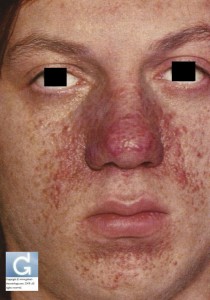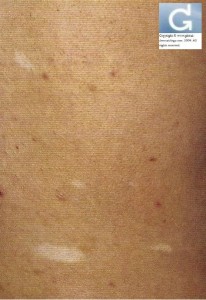Tuberous Sclerosis (TSC)
What is tuberous sclerosis ?
- TSC is also called Bourneville-Pringle disease, Epiloia.
- It affects is of 1 individual out of 15000.
- It is an inherited (genodermatosis) neurocutaneous disorder with systemic and neurological manifestations (phacomatosis).
It what way is it inherited ?
- It is inherited in an autosomal dominant pattern. However this is not absolute as different factors may be involved (variable penetrance).
- It is caused by a mutation of genes which prevent proliferation (tumor suppresion genes):
- hamartin (TSC1, chromosome 9).
- tuberin (TSC2, chromosome 16).
How does it commonly present ?
- It often presents as children having seizures.
- Salient features are a triad of:
- Epilepsy
- Low Intelligence
- Adenoma Sebaceum
How does it present on the skin ?
- Adenoma Sebaceum: These are in fact angiofibromas (smooth red bumps) and are located most commonly on the face. When located on the nails, they are called Koenen tumors.
- Connective Tissue Naevi
- Shagreen Patch: looks like pebbled leather and is usually located on the lower back. Can be located on the forehead. Is caused by the proliferation of collagen.
- Ash-leaf macule: this is caused by impaired transfer of melanosomes (from pigment cells) (melanosomes) to skin cells (keratinocytes). Examination with Wood’s light is warranted, especially when children present with unexplained seizures.
What are the things to look for on the rest of the body ?
- It is important to look for anomalies in the Nervous system, the heart, the kidneys and oral cavity (teeth enamel defects)
- Imagery is therefore necessary (Radiography, MRI scan (Magnetic Resonance Imagery), CT scan (Computed Tomography)).
What is the treatment ?
- Treatments options are quite limited. Neurologists are the main specialists involved as they deal with the seizures.
- Early educational; testing and guidance are warranted
- Skin lesions may be treated with dermabrasion or CO2 laser.
Bibliography: Sterry W. et al. Thieme Clinical Companions: Dermatology. 1st edition in English
Category : Sclérose tubéreuse de Bourneville (TSC) - Modifie le 02.26.2013Category : Tuberous Sclerosis (TSC) - Modifie le 02.26.2013






